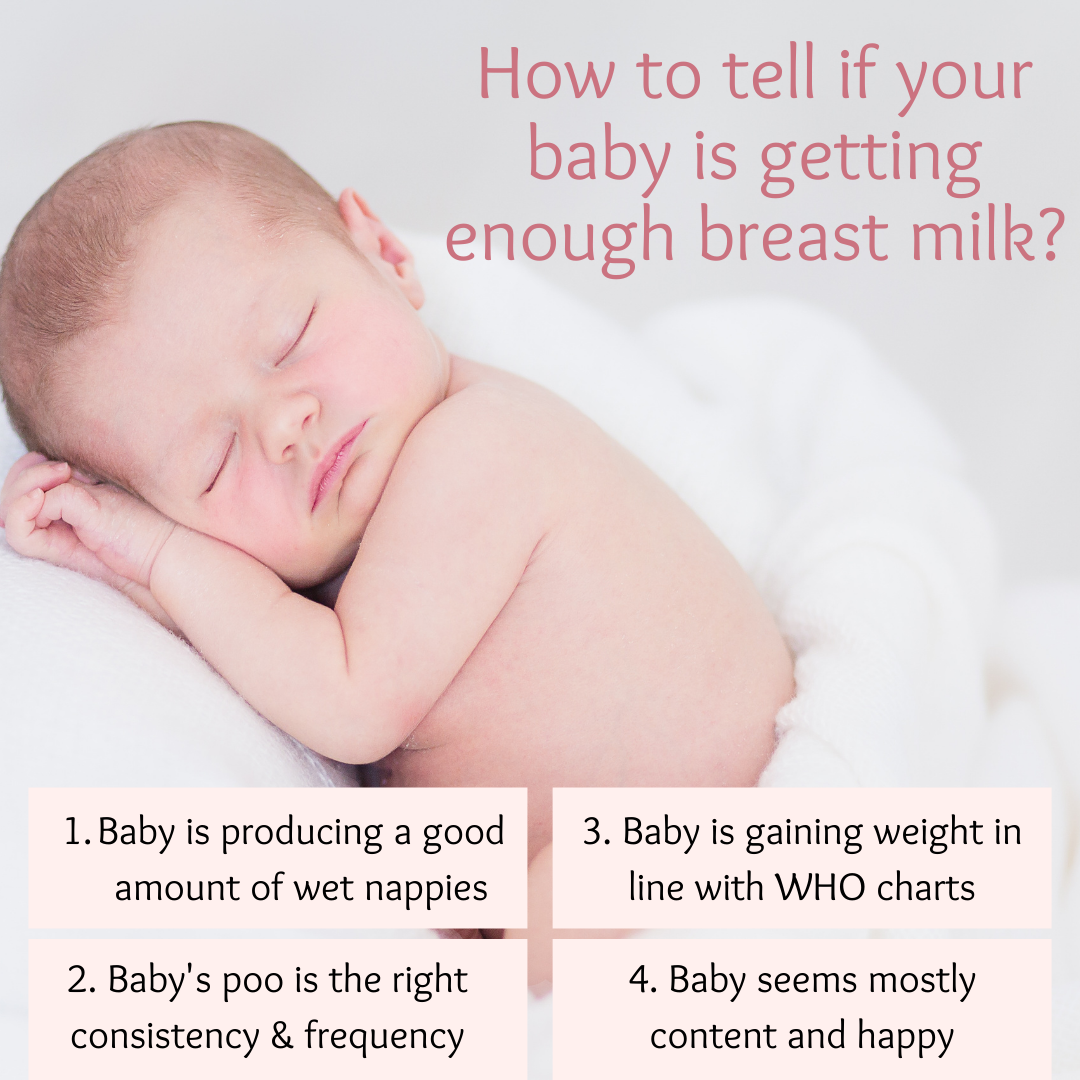How To Tell If Your Newborn Is Getting Enough Milk
Posted by Katie James, IBCLC & Midwife on Mar 25, 2022
Worried about how often your baby is breastfeeding? We asked Katie James, Lactation Consultant and Midwife how to tell if your newborn is getting enough breastmilk. You can watch the video or read the article below
How Often Should I Breastfeed My Newborn Baby?
You should breastfeed your baby every time she seems to want to breastfeed. Some of the early signs of hunger are when your starts making sucking sounds, or turning her head to look for the breast. It is good if you can starting breastfeeding him before he starts crying, as it can be harder to attach at that point.
You do need to breastfeed at least 8 times every 24 hours, and there is no maximum number of times. Expect to feel as though you are breastfeeding all the time during those newborn weeks as your baby helps your body to build up your milk supply and get used to the outside world.
Katie has recorded a video on how often and how long to expect to breastfeed here. Breastfeeding a Newborn: What to Expect.
How to tell if my baby is getting enough breastmilk?
There are just 4 key indicators to find out if your baby is getting enough breastmilk. The first is wees, second is poos, third is weight gain and fourth is contentment. Easy! Remember that and you will be fine.
Breastfeeding in the First Week after Birth
So I'm going to start with the first week because this is probably the most common time when mums are getting used to breastfeeding, getting used to being a new mum and asking the question “how am I gonna know that my baby is getting enough milk?”.
In the first few days there isn't huge volumes of milk. Then by the end of the first week, there is actually quite a lot of milk going through your baby. So what you will see is these changes are occurring every single day.
The best mantra to remember is what goes in must come out. So, if there is enough coming out there is definitely enough going in!
1. How Many Wet Nappies To Expect With a Newborn
So, let's start at the beginning day one after birth. What we are expecting is one wet nappy and it's not going to be very heavy. Day two; 2 wet nappies. Day three; 3 wet nappies. Day four; 4 wet nappies, and day five and onward; 5 heavy wet nappies. Super easy to remember! When you take your baby's nappy off you can hold it in one hand, with a clean nappy in the other hand. You should be able to feel how heavy the dirty nappy is by comparison.
You should be able go, ‘this one's sodden and wet and heavy, and this one feels paper light’. If you're using a reusable nappy then you may have more of these that you go through. You'll definitely be able to see the wetness much easier as well in a reusable nappy. From day five onward, you're going to have five or more heavy wet nappies every day.
2. What is Baby's First Poo Like?
Next we need to think about poos. Now these change a lot in that first week and then they stay pretty much the same. So you might have heard of the first poo that babies do. It's called meconium. It looks like greeny black tar. It is super sticky! If you get it on your fingers (which I can pretty much guarantee you're going to!), you think 'how is it everywhere?!'. It takes some real scrubbing to get off.
Also the same if it's on your baby's bottom, it takes some scrubbing. I would recommend, especially at the beginning, using a cloth or cotton wool with warm water. Try and avoid any harsh chemicals on your baby as much as possible. Use a cloth like a face washer or a flannel with warm water. Gently wipe your baby's bottom to get it off. Sometimes that meconium is pretty tough and needs a bath to get rid of it. It may stick around for longer than that first nappy change.
Breastfed Baby Poo: Frequency and Consistency
The first day or two after birth are meconium poos. By day two or three, it's still going to be meconium, but it might start to change to more brown and not quite so tar like consistency. We're expecting to see that poo start to change because your milk volumes should be starting to increase by day 2, 3 or 4.
At this point we're starting to see a more brown / green color of poo and the consistency will be more squidgy. Once your milk is in, or the volumes have increased and your baby's drinking much more milk, the poo changes to brown / yellow then to bright yellow. This should happen by day 4 at the latest, or 96 hours.
Breast milk poos are like an English mustard mixed with some French whole-grain mustard and watered down a bit. They look bright yellow. Some people say like pumpkin puree or peanut butter, but I definitely like to go with the English mustard analogy. The whole-grain bits are because you do get seedy bits within the breast milk poo and that's normal. It's the separation of the curds and the whey; the different components in the milk coming through. These poos are quite watery and can be quite explosive and look like diarrhea. If you see the poo and it's sitting on top of the nappy it hasn't soaked through like water, then it's a normal breast milk poo. What we're expecting is two of those every day. You may have way more than two. Prepare yourself for the ones that get all the way up the back of the neck, down their sleeves and into their socks. They're called the number three! The explosions, oh they will happen! Also the ones where you think they've done a poo and you start changing their nappy, then another one comes out!
You have all of this excitement to look forward to!
As a midwife and lactation consultant, one of my first questions is ‘ how's the feeding going?’. I'll also ask: ‘how many wet nappies?’, ‘how many poo's and what color of the poo?’, ‘what consistency are they?’. If a mum tells me on day 4 ‘oh god the nappies are so heavy and we've got these bright yellow seedy wet like poos’. Then I can almost guarantee that baby's gained weight so I'm happy.
Remember what goes in must come out! If you're not seeing that, then this is definitely a sign for you to go and seek more specialist lactation help from whoever your health care provider is.
So we've done number one: wees, number two: poos. Number three is weight gain!
3. What is Normal Weight Gain for a Breast Fed Baby?
In the first few weeks the health care professionals looking after you will weigh your baby often in the first week. First at birth, then day 2 or 3 after birth, then again day 5 or 7. It depends on what country you live in, what the policies are in your hospital. It's normal for babies to lose around about 8% of their birth weight in the first 3 days. This is because they're drinking very small volumes of colostrum which I talked about in another video. Once milk volumes increase and they're drinking big volumes each feed, then we're going to start seeing that weight gain increase.
We should see a rapid weight gain over the first 3 to 4 months. The average is between 150g and 200g per week. Then it kind of trails off a bit until they get to about 6 months. After 6 months we see a different type of weight gain again from that period onwards.
We're looking for babies to double their birth weight by around about 6 months of age. You know if I wanted to double my weight in 6 months I'd have to eat a lot! That's why babies feed so much. We're looking at weight gain. Tracking the weight gain and making sure that we're meeting those averages is another sign that your baby is getting enough milk. No matter how often they're feeding. As long as they're feeding within 8 to 12 times every 24 hours after your milk has come in. After that first month the feeding pattern can change. They can still gain loads of weight with less frequent feeding and I will talk about that in another video.
Reference: WHO child weight standards
So first point wees, second point poos, third point weight gain, and fourth point contentment.
4. Is my Baby Content and Happy?
There will, of course, be times when your baby is unsettled, irritable, crying a lot, fussy at the breast. They may be going on, sucking, pulling off, having those moments where you think'I don't know what you want!'. 'Why won't you settle or calm down?'. Baby might have fed on and off for an hour and then they're out like a light and they sleep for an hour to two and a half hours. It's normal for there to be some periods where the baby needs more calming, more security, skin to skin, being swaddled, being rocked, being sung, to having a book read to them and being in contact with you. This is normal.
They've been inside your womb for nine months or longer or a little bit less. All they've ever known is mum, and the muffled beautiful sounds of those people around you and those everyday sounds that are in your life. Expecting them to sleep on their own in a cot, with silence, it's not going to happen for a good few days or weeks. Wanting to be in close contact with you often is normal. Having periods of irritability or unsettledness is also normal. But if, in general, when they feed and they've had enough food they're doing loads of wees and poos and they're gaining weight that is a definite sign that you have a content and healthy well-fed baby.
If you feel that your baby is not content and there are signs that your baby is very upset all the time or very long periods, and is very difficult to settle then I would highly recommend seeking expert information and advice and support from a health care professional who is trained in these matters.
For now these are your main tips to know that you are giving your baby enough breast milk.
Happy breastfeeding! I will be back with another video in the near future.

About the author 
Katie James, IBCLC has helped thousands of women through their breastfeeding challenges during those early newborn days. Katie's extensive knowledge and experience, coupled with her down to earth, practical approach is reassuring and empowering for new mums. Find out more about Katie here.


